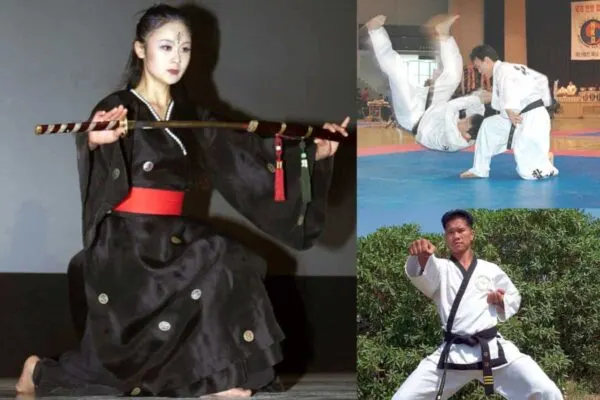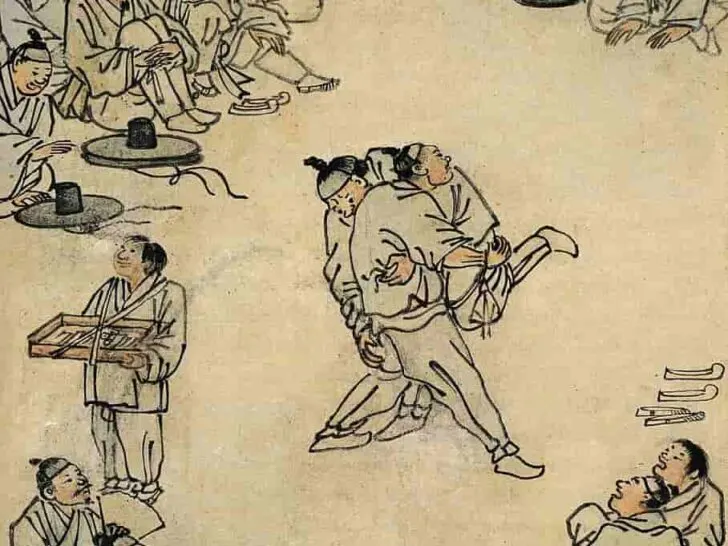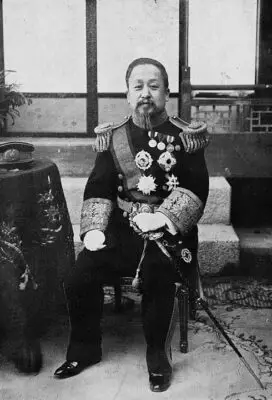
Credit: Minivalley (top right pic)
Martial arts practice is deeply rooted in Korean tradition, history, and culture. Throughout history, the people of Korea have developed dozens of different combat systems for different purposes. In a nutshell, Korean martial arts styles can be summarized as follows:
Korean martial arts styles are primarily centered on striking, and Taekwondo is the best example of their striking art. Korean martial arts styles also include grappling arts (Ssireum), hybrid arts (Hapkido), and weapon-based arts (Kumdo). However, these are less well-known than Taekwondo.
Continue reading this article to expand your knowledge of Korean martial arts, including their history, development, and some of the most popular Korean martial arts styles you may have yet to hear of.
A Brief Summary of Korean Martial Arts History
The history of Korean martial arts dates all the way back to the Goguryeo (Korean: 고구려) dynasty, which ruled from 37 BC to 668.
The two combat systems recognized as the oldest during that period were Ssireum and Subak. These two combat systems were a part of the military training and were also practiced for basic physical education by the Korean people. Ssireum is a concept based on wrestling and grappling, while Subak is more oriented toward striking.


Credit: Wikimedia (right pic)
The development of Korean martial arts continued through the Goryeo (Korean: 고려) dynasty (935–1392). This was an era when the sports variation of Subak had emerged which quickly became one of the most popular sports activities in the country.
But with the Mongol conquest, Koreans developed expertise in using the composite bow and mounted archery during a rebellion against their Mongol Yuan rulers. Composite bows, in particular, proved to be very effective on the battlefield.
Later, during the Joseon Dynasty (Korean: 조선), the Korean combat systems would be influenced by the Chinese and Japanese martial arts. During the 17th and 18th centuries, the Korean army started incorporating various other weapons into their training, such as double-sword fighting, spear fighting, stick fighting, and many others. They also adopted hand-to-hand grappling and striking techniques from Judo, Jujutsu, Aikido, Kung Fu, Karate, etc.
Emperor Gojong himself once invited the finest sword masters from Japan to start teaching Korean soldiers and police officers martial arts techniques. At the end of the 19th century, he established Gungdo, the art of archery, as the official sport.

Original systems like Ssireum and Gungdo continued to be practiced during the Japanese occupation in the early 20th century. But after the liberation in 1945 from Japanese colonialism, Korean martial arts schools (kwans) would unite and create a unified Korean system called “Tang Soo Do,” rooted in the traditional arts Taekkyon, Subak, and Gwonbeop. The name would later change to “Taekwondo” and become a national and Olympic sport.
RELATED: What Are the Different Styles of Japanese Martial Arts?
Korean Striking Arts
Taekwondo
Although the traditional concept includes limited grappling techniques, Taekwondo (TKD) is primarily classified as a striking martial art. TKD emerged after World War II in the 1950s as a Korean military self-defense combat system. Its origins come from traditional Korean practices such as Subak, Taekkyon, and Gwonbeop.
In terms of techniques, Taekwondo is versatile as it includes hand and leg strikes as well as limited grappling. The main emphasis is on kicks because its founders believed legs were more powerful and versatile weapons compared to punches, which have limited range and power.
As a result, TKD students spend most of their time practicing all types of different jumping and spinning kicking techniques. Punches are considered a secondary weapon, used mostly for direct attacks and to set up kicks. Due to its heavy emphasis on kicks, each athlete must develop a high level of flexibility, as well as strength and cardio.
Taekwondo practice also emphasizes realistic methods of training. Students often engage in full-contact sparring, where they practice how to apply techniques in real-life situations. They also do various types of breathing exercises to improve focus and learn how to stay calm in stressful situations.
In its initial form, Taekwondo was designed for real-life fighting and training a person for various types of self-defense situations. But over the years, the emphasis on training shifted from self-defense to competition, especially after Taekwondo became a national sport in Korea and an Olympic sport.
As a result, most modern schools emphasize sports variation, where students learn how to obey the rules and win matches rather than how to fight. The learning syllabus emphasizes kicks, footwork, and punches to the upper body below the neck. Although some schools still stick to traditional practices, they might be hard to find.
Tang Soo Do
Although some people think Tang Soo Doo and Taekwondo are the same, Koreans see them as two separate systems. Tang Soo Do includes various techniques from northern Chinese martial arts, karate, and traditional Korean arts such as Subak and Taekkyeon. It never became as popular as other arts, primarily for political reasons.
The system was put together in 1944 by nine leading Korean martial art schools called “Kwans.” It was the unification of different martial arts practices into one unified system.
However, the Korean political leadership didn’t want to use the name “Tang Soo Do” at the time. For them, the name was associated with China, notably the word “Tang,” which represented the Chinese Tang Dynasty. As a result, they first changed the name to “Tae Kwon Do” before changing the entire emphasis from traditional values and principles to sport and competition.
In Korea and the martial arts world in general, Tang Soo Doo is often considered the original and traditional version of the unified martial art styles created by nine main “kwans.” At the same time, “Taekwondo” is a sport variation that came almost a decade later.
Tang Soo Doo primarily focuses on kicking techniques, punches, knee and elbow strikes, and blocks. The training syllabus emphasizes forms known as “Hyeong” as a method to memorize the moves and stamp them into muscle memory. Later, students move to more realistic teaching methods, such as free sparring.
Most schools include 9 main forms in their curriculum from 9 main kwans (schools). Students also learn self-defense techniques, notably at close range, such as against grabbing.
In modern times, many Korean martial arts schools continue to teach Tang Soo Do. Over the years, many of these schools would develop their own variations or styles of the system:
- Chung Do Kwan
- Moo Duk Kwan
- Mi Guk Kwan
- Moo Yea Tang Soo Do
- American Tang Soo Do
Taekkyon
Taekkyon is widely regarded as the oldest Korean martial art. It has influenced the birth of many other styles, including Taekwondo. This style combines fluid dance-like movements resembling Capoeira with striking techniques using hands and feet while also incorporating some grappling techniques.
Taekkyon is listed as a striking-based martial art. It teaches a person how to use all limbs to throw punches, kicks, knee, and elbow strikes, as well as defensive blocks. However, the primary weapons remain all types of kicking techniques. The key is to learn how to use triangular footwork (pumbalki) in coordination with fast and direct hand and leg attacks. Apart from the fist, Taekkyon practitioners also strike with the palm.
On top of that, Taekkyon includes grappling skills. The goal is to learn how to combine dynamic, constant movement in all directions with hand and foot attacks to manipulate the opponents’ balance and take them down with trips and throws. The system also covers self-defense moves such as attacking pressure points, joint locks, and headbutts.
In modern times, there are four main Taekkyon organizations in Korea:
- Widae Taekkyeon Preservation Society
- Korea Traditional Taekgyeon Association (KTTA)
- Korea Taekkyon Federation (KTF)
- Kyulyun Taekyun Association (KTK)
RECOMMENDED READING: Why Does Taekwondo Have a Bad Reputation?
Korean Grappling Arts
Ssireum
Ssireum is one of the oldest Korean martial arts, primarily focusing on wrestling. It is conceptually very similar to wrestling and Judo, with the main difference being the rules. In Ssireum, if any part of the opponent’s body above the knee touches the ground, the competitor wins the match.
Next, practitioners wear long fabric belts around their waists and thighs, which allows them to pull and lift the opponent in a posture of the waist. The key is manipulating the opponent’s weight and turning their torso to execute a throw. There are no striking or self-defense tactics, as Ssireum is primarily a combat sport.
Ssireum is a national sport in Korea, practiced since the Goguryeo period. The matches take place in a circular ring that is around 7 meters in diameter, and it visually looks a lot like Sumo. But unlike in Sumo, you don’t get any points for pushing the opponent outside the pit area. Instead, the winner of the match is a wrestler who manages to force the opponent to touch the ground with any part of the body that is at knee level or higher.
Korean Weapons Arts
Korea has a long history of weapon-based martial arts, with some of the systems dating back to the 1st century BCE. Following is a brief explanation of the most popular ones.
- Gungdo (a.k.a. Gukgung) — is the art of the reflex bow and is believed to have been developed by the founder of Goguryeo, Go Jumong, a highly skilled archer. It became a key part of military training during the Mongol conquest of Korea when the composite bow proved to be the most effective method in a fight against the Mongols. It remained a part of arm combat training up until the 19th century.
- Kumdo — translates to the “way of the sword,” is a Korean weapon-based martial art derived from Japanese Kendo. One of the major differences between the two is related to the native terminology, competition rules, and small uniform changes. Each practitioner wears a Hogu uniform, including a helmet, cotton craft under the helmet, a chest protector, a leather skirt worn around the waist, and hand protectors. People also use the word “Kumdo” as a universal term for all the Korean swordsmanship arts.

Photo by Bruce W Sims
- Hwa Rang Do — is a self-defense martial art that includes striking, grappling, and weapon training. Its origins go as far back as 2000 years ago, but the modern variation was developed in the 1960s by brothers Jong Bang Lee and Joo Sang Lee. Some of the weapons used in Hwa Rang Do are Nunchucks (SSang Jyel Bong), long staff (Jang Bong), and swords (Jang Gum).
Korean Hybrid Arts
Hapkido
Hapkido is the most famous hybrid Korean martial art that has spread worldwide. It is a complex combat system that focuses on both armed and unarmed fighting techniques. Koreans see it as the ultimate self-defense system designed to cover most scenarios. It is rooted in traditional arts like Taekkyon, Chinese arts, and Japanese arts such as Judo.
However, Hapkido is not entirely a full-contact martial art. It rather stands somewhere in the middle between hard and soft. Students learn how to execute techniques in a soft manner, like in Aikido, for example, as the goal is to utilize opponents’ attacking momentum against them and redirect the attack. But on the other side, there are segments of training where the intensity increases significantly when it comes to striking.
Hapkido principles heavily revolve around fast movement, executing techniques in a natural, flowing, and relaxed manner, and manipulating the opponents’ energy.
In terms of striking, Hapkido covers all the ranges. Like in other Korean styles, kicking techniques are the most important. But in contrast with most other modern arts like Taekwondo, Hapkido focuses heavily on the kicks below the waist (low/leg kicks).
Hand strikes are considered secondary weapons, primarily used to set up kicks or close the distance before applying joint locking and throwing techniques. Students learn how to strike with punches, open hands, and fingernail targeting the throat and eyes. The curriculum also includes different blocks and counterattacks.
Hapkido grappling techniques originate from Aikido and Jujutsu and mainly consist of various types of throws, wristlocks, and elbow locks.
Gongkwon Yusul
Gongkwon Yusul is a modern Korean combat system founded in 1996 by Kang Jun. It combines striking and grappling techniques rooted in martial arts such as Hapkido, Jujutsu, Judo, and Hakko-ryu. It is very similar to Hapkido regarding techniques, but the overall application and principles differ significantly. While Hapkido emphasizes forms and static application, Gongkwon Yusul is geared toward sparring.
Gongkwon Yusul primarily focuses on the spontaneous and free-flowing application of techniques in situations that resemble fighting in real life. Students learn how to mix hand and leg strikes with locking and throwing techniques, and training also includes groundwork where students practice techniques and skills from Judo and BJJ.
In some way, Gongkwon Yusul is designed to resemble modern MMA practice and freestyle combat. However, it retains many traditional elements of Korean martial arts, such as uniforms, ranking, and terminology.
Teukgong Moosool
The South Korean special forces developed Teukgong Moosool in the 1970s as a countermeasure to North Korean Special Forces infiltrating their territory. North Korean special forces easily defeated the Korean commandos in hand-to-hand combat. Therefore, there was an urgent need for a new form of self-defense.
Teukgong Moosool is a hybrid martial arts system that can be used with or without weapons. It was created by gathering input from grandmasters of different styles of Korean martial arts.
The entire focus of Tekgong Moosool practice is on self-defense and preparing a person for real-life combat. Thus, training is intense and involves a lot of hard sparring. Practitioners often train with standard attacking weapons such as knives and bats.
